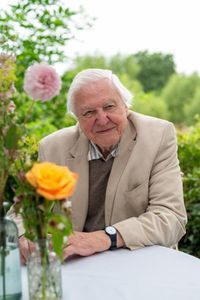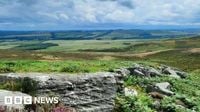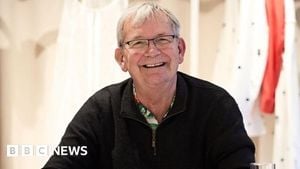In the rolling hills and ancient woodlands of Northumberland, a race against time is unfolding. The storied Rothbury Estate, a 9,486-acre swath of upland, moor, and farmland that has belonged to the Dukes of Northumberland for nearly seven centuries, is at the center of a high-stakes conservation campaign. The Wildlife Trusts, a coalition of 46 UK conservation charities, together with Northumberland Wildlife Trust, are urgently seeking to raise £30 million (about $40 million) to purchase and protect this immense estate before it can be sold off and carved up for commercial purposes.
The Rothbury Estate, put on the market in 2023 by Lord Max Percy, the youngest son of the Duke of Northumberland, represents the largest landholding to be offered for sale in England in three decades, according to BBC. Spanning about 15 square miles (38.8 square kilometers) and stretching from Druridge Bay on the east coast to the Scottish border near Kielder Forest, it is a landscape rich in history and biodiversity. It features forests, rivers, the dramatic Simonside Hills, and even prehistoric rock carvings—an evocative reminder of the people who have called this land home over millennia.
Sir David Attenborough, the beloved broadcaster and naturalist, has thrown his considerable support behind the campaign. In a statement quoted by CNN, Attenborough painted a vivid picture: "People know and love the Simonside Hills that rise here. They walk the ridges and listen for the calls of the curlew. They watch for red squirrels and admire the views as they scramble among the crags. They walk along its remote paths and marvel at the astonishing rock carvings left by our distant ancestors, who once lived here." His words underscore both the estate’s natural beauty and its deep cultural roots.
But the clock is ticking. The Wildlife Trusts and Northumberland Wildlife Trust have until September 2026 to raise the remaining funds, or risk seeing the estate broken up and sold for uses that could include commercial logging and intensive agriculture. Such fragmentation, conservationists warn, would not only disrupt the landscape but also squander a rare opportunity for large-scale nature restoration.
In October 2024, the first step in this ambitious plan was taken when the charities succeeded in purchasing the western portion of the estate, including the Simonside Hills and a patchwork of lowland, woodland, riverbanks, and farmland. This acquisition was celebrated as the foundation for an even grander vision: the creation of a 40-mile (64-kilometer) "wild" corridor, a continuous stretch of restored habitat linking the North Sea coast to the Scottish border. As Craig Bennett, CEO of The Wildlife Trusts, told BBC, "That's why it's such a unique opportunity. We know that the UK is one of the most nature-depleted countries in the world and I've had enough in my lifetime of looking at lots of graphs that point nature going downwards. We want to bend the curve on that and start to bring nature back at scale."
So far, the fundraising campaign has gathered about £8 million, with donations ranging from as little as £5 to as much as £5 million. The effort is as much about community as it is about conservation. Local people are being called upon to help shape the future of the estate, with plans to develop new walking paths, a visitor and education center, and to create new jobs tied to nature recovery and eco-tourism. According to CNN, the campaign has resonated especially strongly in Northumberland, where many see the estate as a shared heritage and a symbol of what can be achieved when people and nature thrive together.
The Rothbury Estate’s biodiversity is already impressive, but conservationists believe it could be even richer. The land is home to rare and threatened species such as the curlew, mountain bumblebees, lapwings, cuckoo, merlin (the UK’s smallest falcon), Atlantic salmon, and critically endangered eels. Red squirrels, a species vanishing from much of England, still find refuge here. The trusts’ plans are ambitious: they envision reintroducing large herbivores—ponies, hardy cattle, and perhaps even bison—to graze the land naturally, and hope that pine martens, beavers, and golden eagles could one day return to the landscape.
Mike Pratt, CEO of Northumberland Wildlife Trust, described the purchase as a "once-in-a-lifetime opportunity" to restore nature at scale. Speaking to CNN, he emphasized the importance of acting boldly: "We’re after a really big site like this because it’s not enough to own little bits anymore. We’ve got to really do something at scale if we want to restore nature to 30% of [UK] land; it’s 7% at the moment." This aligns with the UK government’s commitment to protect 30% of its land and sea for nature by 2030, a target set under international agreements.
Restoration won’t just be about wildlife. The Wildlife Trusts have pledged to work closely with local farmers, aiming to promote nature-friendly farming and sustainable meat production that supports the local economy. As Pratt told CNN, "We need to invest in nature if we want it to work." While some have expressed concerns about how conservation might affect those currently working the land, the Trusts insist that their approach will be collaborative, seeking to balance ecological restoration with the needs and livelihoods of the community.
Yet the stakes remain high. If the full £30 million isn’t raised by September 2026, the estate could be divided and sold for less sustainable uses. As Pratt warned, "It would break up the landscape, and we’d lose this once in a lifetime nature opportunity." The potential for the site to become a patchwork of commercial forestry and intensive agriculture looms large, threatening both its ecological integrity and the vision of a connected, thriving wild corridor.
For Attenborough, the campaign is more than just another conservation project—it’s a chance to inspire hope and action at a pivotal moment. "Please help us make this vision a reality," he urged in his public appeal, as reported by BBC. The Rothbury Estate stands as a testament to the intertwined destinies of people and nature, a place where ancient history and modern ambition meet. Whether this vision becomes reality now rests in the hands of those willing to invest in the land’s future—before time runs out and the chance slips away.
As the campaign enters its critical final year, the fate of Rothbury Estate will serve as a barometer for the UK’s commitment to reversing nature’s decline. The outcome will not only shape a landscape but also set an example for conservation efforts across Britain and beyond.






